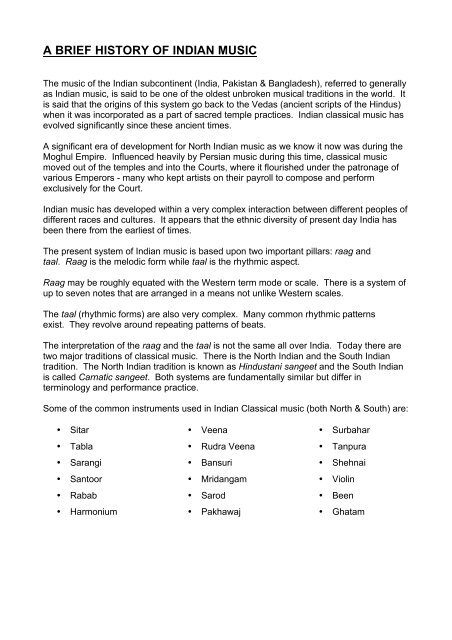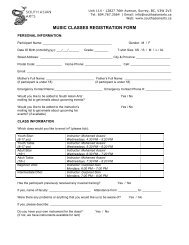about the artist - Mohamed Assani
about the artist - Mohamed Assani
about the artist - Mohamed Assani
You also want an ePaper? Increase the reach of your titles
YUMPU automatically turns print PDFs into web optimized ePapers that Google loves.
A BRIEF HISTORY OF INDIAN MUSIC<br />
The music of <strong>the</strong> Indian subcontinent (India, Pakistan & Bangladesh), referred to generally<br />
as Indian music, is said to be one of <strong>the</strong> oldest unbroken musical traditions in <strong>the</strong> world. It<br />
is said that <strong>the</strong> origins of this system go back to <strong>the</strong> Vedas (ancient scripts of <strong>the</strong> Hindus)<br />
when it was incorporated as a part of sacred temple practices. Indian classical music has<br />
evolved significantly since <strong>the</strong>se ancient times.<br />
A significant era of development for North Indian music as we know it now was during <strong>the</strong><br />
Moghul Empire. Influenced heavily by Persian music during this time, classical music<br />
moved out of <strong>the</strong> temples and into <strong>the</strong> Courts, where it flourished under <strong>the</strong> patronage of<br />
various Emperors - many who kept <strong>artist</strong>s on <strong>the</strong>ir payroll to compose and perform<br />
exclusively for <strong>the</strong> Court.<br />
Indian music has developed within a very complex interaction between different peoples of<br />
different races and cultures. It appears that <strong>the</strong> ethnic diversity of present day India has<br />
been <strong>the</strong>re from <strong>the</strong> earliest of times.<br />
The present system of Indian music is based upon two important pillars: raag and<br />
taal. Raag is <strong>the</strong> melodic form while taal is <strong>the</strong> rhythmic aspect.<br />
Raag may be roughly equated with <strong>the</strong> Western term mode or scale. There is a system of<br />
up to seven notes that are arranged in a means not unlike Western scales.<br />
The taal (rhythmic forms) are also very complex. Many common rhythmic patterns<br />
exist. They revolve around repeating patterns of beats.<br />
The interpretation of <strong>the</strong> raag and <strong>the</strong> taal is not <strong>the</strong> same all over India. Today <strong>the</strong>re are<br />
two major traditions of classical music. There is <strong>the</strong> North Indian and <strong>the</strong> South Indian<br />
tradition. The North Indian tradition is known as Hindustani sangeet and <strong>the</strong> South Indian<br />
is called Carnatic sangeet. Both systems are fundamentally similar but differ in<br />
terminology and performance practice.<br />
Some of <strong>the</strong> common instruments used in Indian Classical music (both North & South) are:<br />
• Sitar<br />
• Tabla<br />
• Sarangi<br />
• Santoor<br />
• Rabab<br />
• Harmonium<br />
• Veena<br />
• Rudra Veena<br />
• Bansuri<br />
• Mridangam<br />
• Sarod<br />
• Pakhawaj<br />
• Surbahar<br />
• Tanpura<br />
• Shehnai<br />
• Violin<br />
• Been<br />
• Ghatam



